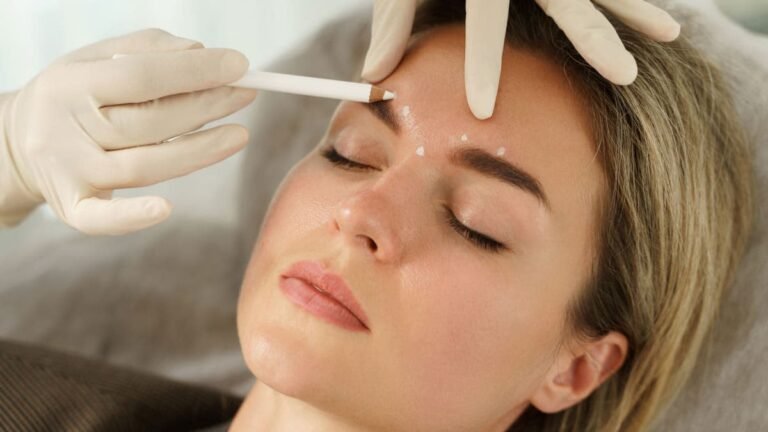
[ad_1]
It’s not uncommon for the word “Botox” to conjure images of frozen faces, permanently surprised expressions, or smiles that just don’t look quite right. This is clearly not the average person’s goal, which begs the question: Is smoothing wrinkles really worth it if you can no longer make the typical human facial expressions? For many of us, the answer is no.
Enter: Baby Botox. The hottest new trend in cosmetic dermatology. This procedure touts the ability to smooth wrinkles without any of the frozen-in-your-face look or feeling.
If this sounds intriguing to you, you’re not alone. Baby botox has soared in popularity. But how is baby botox different from traditional botox? And how does it work? Let’s break it down.
Related: Botox and Fillers Are Both Popular Procedures—So Which One’s Right for You? Dermatologists Explain
What is Baby Botox?
According to Dr. Samantha Ellis, a Board-Certified Dermatologist and Clinical Instructor of Dermatology at UC Davis,“‘baby” Botox is a concept in aesthetic medicine that typically refers to the use of low doses of Botox to subtly soften certain facial expressions.” This can help you achieve results like lifting the brows, minimizing frown lines and reducing wrinkles that start to develop from making the same facial expressions year after year.
The term baby Botox has really only been around for a few years—a quick look at Google trends will tell you that interest has risen steadily since 2019—but according to Dr. Ellis, baby Botox is still Botox, just with a new “coined term” for the desired results. As she explains it, “I think the term originated because getting ‘regular’ Botox has been a bit stigmatized and patients tend to associate it with a ‘frozen’ or unnatural look.”
The reality though, is that all Botox can lead to results like minimizing facial lines, raising eyebrows and reducing wrinkles without reducing your movement in a way that’s noticeable, as long as it’s injected at the right dose and location for the person’s musculofascial structure. “I think some people assume only ‘baby’ Botox can yield these results,” says Dr. Ellis. But the reality is that “all Botox should have the same effect: rejuvenating and refreshing the face without distorting someone’s features or making them look overdone,” she continues.
How Many Units of Botox is Baby Botox?
It’s impossible to give hard and fast rules about how many units of Botox a person will need. As Dr. Ellis explains it, “The reality is, everyone’s face is different, and the dose of Botox used should be based on their unique anatomy and desired cosmetic outcome.” Botox injections are measured in units that can be distributed in the desired locations, including the forehead, eyebrows, around the eyes, sides of the nose and the mouth.
How many units and where they’re injected “depends on a person’s unique anatomy, their muscle strength and movement patterns, and the areas being treated,” says Dr. Ellis. For example, treating the upper face, which includes the glabella (or “11” lines) between the brows, crow’s feet and forehead would typically require between 15 and 30 units.
How Much Does Baby Botox Cost?
The American Society of Plastic Surgeons (ASPS) reported in 2019 that a single unit of Botox costs around $10 to $15, so a treatment using 30 units would cost somewhere around $400. “The duration of Botox, at least in part, depends on the dose used, and I find that ‘baby’ Botox often starts wearing off about four to six weeks faster than ‘regular’ Botox,” says Dr. Ellis. She communicates to her patients that they will likely see a significant return of muscle movement in six weeks. In that sense, it is definitely less cost-effective than regular Botox, which can last three to four months.
Related: How Long Does Botox Last?
Is Baby Botox Right for You?
According to Dr. Ellis, the popularity of the term “baby Botox” has led to a lot of requests for this treatment approach in her office. But this can also have a downside. “In my mind, using ‘baby’ Botox is using fewer units than I would typically recommend,” she explains. In fact, she typically reserves a baby Botox approach for patients who are new and nervous about the procedure or potential side effects. Otherwise, baby Botox is really what she gives to patients who don’t need a higher dose to get the desired results due to their facial muscles and anatomy. “If I happen to be using a low number of units on a patient because their anatomy and muscle movement lends itself best to that small dose, I don’t consider it ‘baby’ Botox, just appropriate Botox for them!”
So, is baby Botox right for you? It might be, especially if you’re nervous about getting Botox for the first time. In that case, requesting baby Botox might help you ease your way into the world of Botox, and see how the experience goes for you. But eventually, with what we’ve learned from Dr. Ellis, it makes sense that down the line you’d leave the dosage decision to the professional, who has been trained to evaluate your unique facial anatomy and recommend a treatment that will give you the best results.
Up next: Botox Is an Effective Treatment for Migraines—but Is It Safe? Doctors Weigh In
Sources:
[ad_2]
Source link